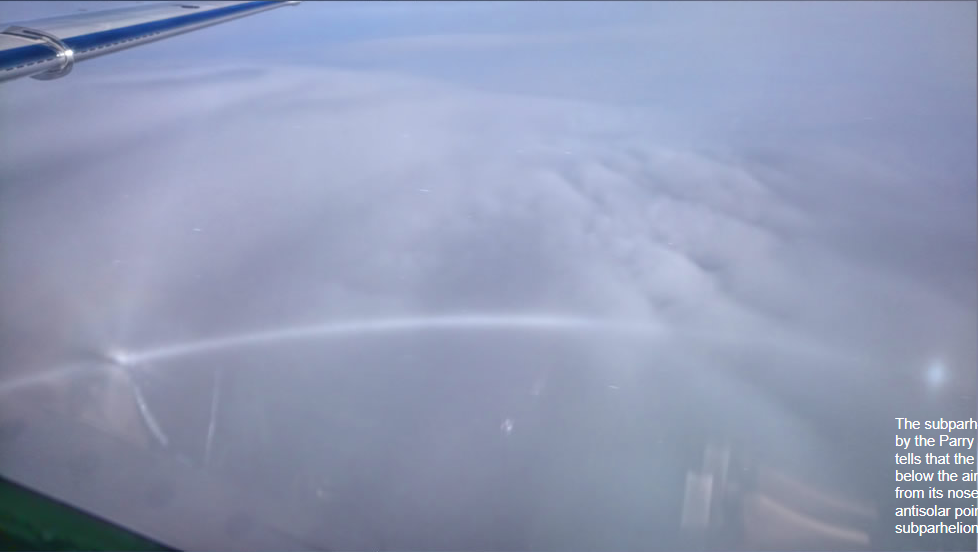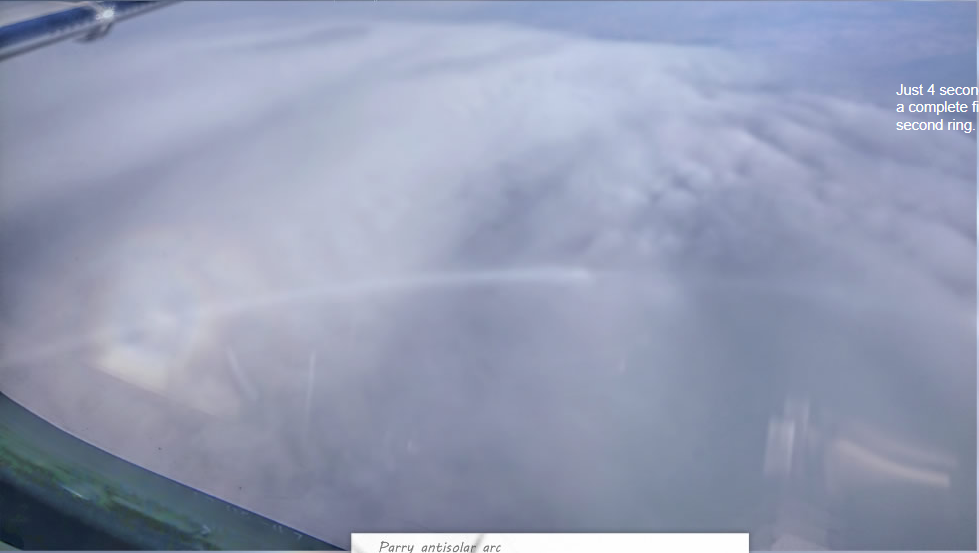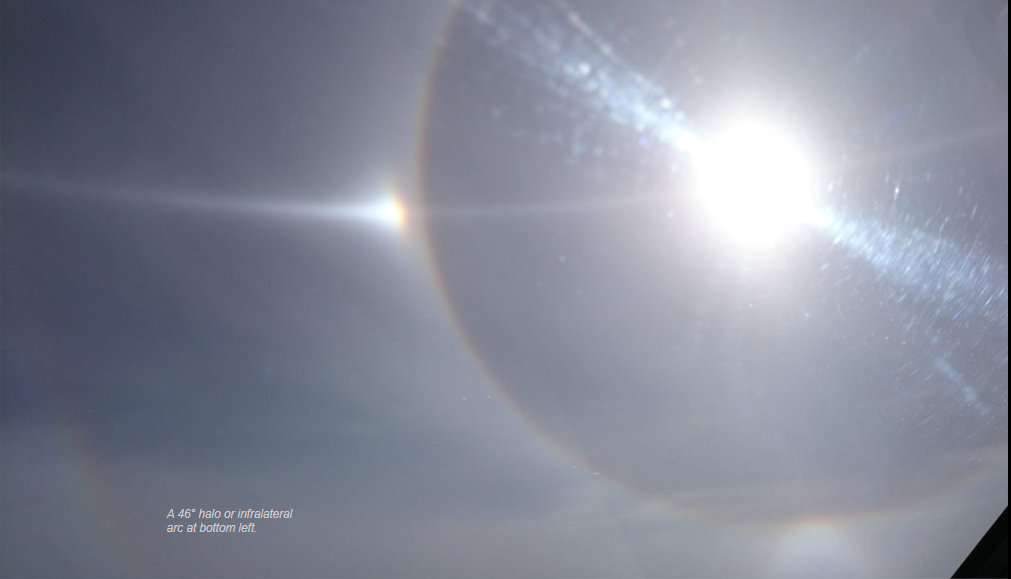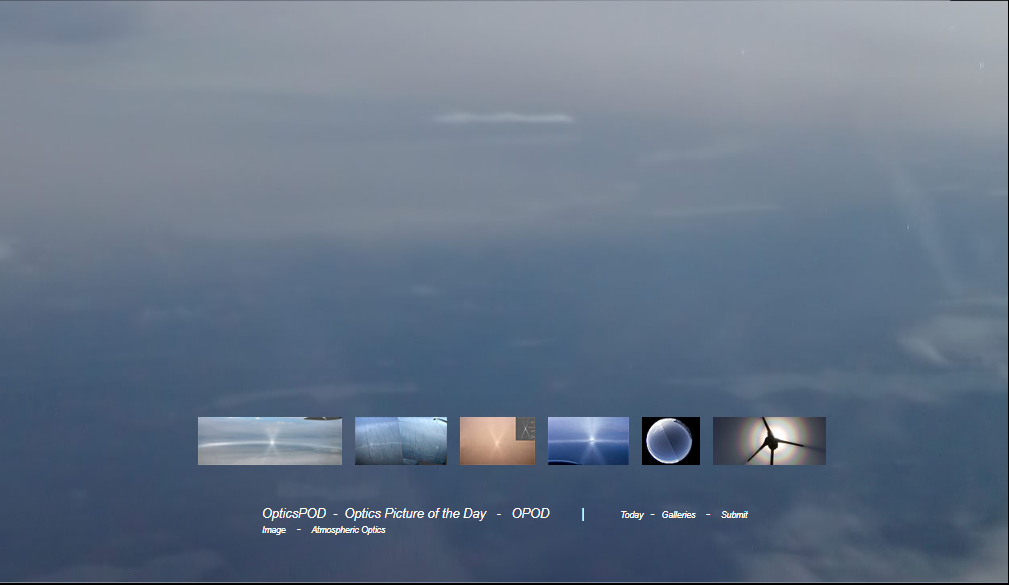Subhorizon halos & Glory - OPOD
Subhorizon Halos & Glory - Exploring Atmospheric Optics
Have you ever looked up at the sky and witnessed a mesmerizing display of halos and a captivating phenomenon known as a glory? These atmospheric optics phenomena can create a spectacle that leaves us in awe. Recently, pilot Mike Plouffe had the opportunity to witness and capture such a display from the cockpit of an aircraft flying at approximately 26,000 feet over Alberta, Canada.
The Enchanting Halo Display
As Plouffe and the first officer gazed out the aircraft window, they were greeted by an extraordinary halo display accompanied by a glory. The spectacle included two complete parhelic circles. The upper parhelic circle stretched through the sun, while the lower one appeared against the clouds below the horizon. Additionally, there were antisolar arcs, sub 120-degree parhelia, a 22-degree halo, sundogs, tangent arcs, and even a transient glory!
The images captured by Mike Plouffe during this encounter provide us with a glimpse into the breathtaking beauty of these atmospheric phenomena. In one of the images, we can see the subparhelic circle prominently displayed on the left. The Parry antisolar arc forms a cross at the far left of the image. Interestingly, the shadow of the aircraft reveals that the halo forming layer was not far below the airplane, indicating that the photo was taken from its nose. A faint glory can also be observed coloring the antisolar point. On the right side of the image, we can see a rare 120-degree subparhelion.
The Mysterious Glory Formation
Glories, unlike many other halo phenomena, are formed by water droplets rather than ice crystals. At an altitude of 26,000 feet, supercooled water droplets can exist. However, they are not in equilibrium with ice crystals and cannot coexist for long periods. Due to their higher vapor pressure, these droplets evaporate, with the moisture condensing as ice.
This raises an intriguing question: how is the glory formed? One possibility is that the droplets responsible for the glory formation exist in a lower cloud layer. Another, less probable explanation, involves the presence of ice spheres. However, the smoothness required for the formation of surface waves necessary for a glory to occur makes this explanation unlikely.
The Puzzle of Glory Formation by Ice
While the formation of glories by ice remains a subject of fascination and debate, Philip Laven has offered valuable insights into this topic. Despite the uncertainty surrounding the exact mechanisms involved, the captivating nature of glories continues to inspire researchers and enthusiasts alike.
The Subparhelic Circle and Brightness Variation
One of the images captured by Mike Plouffe reveals an intriguing brightness variation along the subparhelic circle and bright sub 120-degree parhelia. These variations suggest the presence of plate crystals with a triangular aspect, where alternate vertical faces are long and short.
The sun's elevation during this display was approximately 25 degrees. The angle of the cross at the antisolar (sub anthelic) point aligns with Parry-oriented columns forming an antisolar arc. The presence of randomly oriented crystals and singly oriented columns is evident from the halos around the sun. These crystals and halos were constantly changing as the aircraft passed through the ice crystal layer.
Exploring Antisolar Arcs
Antisolar arcs are another captivating atmospheric optics phenomenon. By delving into the intricacies of these arcs, we can gain a deeper understanding of their formation and the unique atmospheric conditions required for their occurrence. Further exploration into antisolar arcs can shed light on the mesmerizing halo displays witnessed by Mike Plouffe during his flight.
A Captivating World of Atmospheric Optics
The images captured by Mike Plouffe during his flight over Alberta, Canada, offer us a glimpse into the captivating world of atmospheric optics. The intricate interplay of light, water droplets, and ice crystals gives rise to awe-inspiring phenomena such as halos and glories. These displays serve as a reminder of the wonders that surround us in the atmosphere.
As researchers continue to study and unravel the complexities of atmospheric optics, we can anticipate further insights into the formation and behavior of these mesmerizing phenomena. By exploring the science behind these captivating displays, we deepen our appreciation for the natural world and the intricate processes that shape our skies.
So, next time you find yourself gazing up at the sky, take a moment to appreciate the enchanting beauty of atmospheric optics. Who knows what hidden wonders may be waiting to reveal themselves above the horizon?
Aerial Halos & Glory
Mike Plouffe was piloting an aircraft at ~26,000 feet over Alberta, Canada when he and the first officer saw an incredible halo display accompanied by a glory.
There were two complete parhelic circles, the upper one through the sun and, below the horizon against cloud, a subparhelic circle. Add antisolar arcs, sub 120 degree parhelia, a 22 degree halo, sundogs, tangent arcs and a transient glory!
All images ©Mike Plouffe, shown with permission

The subparhelic circle. At far left a cross formed by the Parry antisolar arc. The aircraft shadow tells that the halo forming layer was not far below the airplane and that the photo was taken from its nose. A very faint glory colours the antisolar point. At right is a rare 120° subparhelion.

Just 4 seconds earlier the glory was bright with a complete first ring and distorted partial second ring.
Glories are formed by water droplets rather than ice crystals. Supercooled water droplets can exist at 26,000 feet but they are not in equilibrium with ice crystals and cannot long co-exist. The droplets have a higher vapour pressure and evaporate with the moisture condensing as ice.
The glory is therefore puzzling. It could be formed by droplets in a lower cloud layer. Far less probable are ice spheres. The latter are never likely to be sufficiently smooth to allow the surface waves necessary for glory formation.
A thanks to Philip Laven for comments on glory formation by ice.

The brightness variation along the subparhelic circle and the bright sub 120° parhelia suggest the presence of plate crystals with a triangular aspect, i.e. alternate vertical faces long and short.
See here and here for ray paths and more on sub 120° parhelia.
The sun elevation was about 25° and the angle of the cross at the antisolar (sub anthelic) point is consistent with Parry oriented columns forming an antisolar arc.
The halos around the sun show that randomly oriented crystals and singly oriented columns were also present. Crystals and halos were changing very quickly as the jet went through the ice crystal layer.
Much more on antisolar arcs here and here.


Note: this article has been automatically converted from the old site and may not appear as intended. You can find the original article here.
Reference Atmospheric Optics
If you use any of the definitions, information, or data presented on Atmospheric Optics, please copy the link or reference below to properly credit us as the reference source. Thank you!
-
<a href="https://atoptics.co.uk/blog/subhorizon-halos-glory-opod/">Subhorizon halos & Glory - OPOD</a>
-
"Subhorizon halos & Glory - OPOD". Atmospheric Optics. Accessed on November 21, 2024. https://atoptics.co.uk/blog/subhorizon-halos-glory-opod/.
-
"Subhorizon halos & Glory - OPOD". Atmospheric Optics, https://atoptics.co.uk/blog/subhorizon-halos-glory-opod/. Accessed 21 November, 2024
-
Subhorizon halos & Glory - OPOD. Atmospheric Optics. Retrieved from https://atoptics.co.uk/blog/subhorizon-halos-glory-opod/.